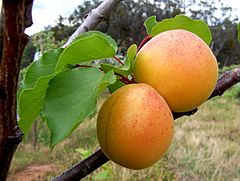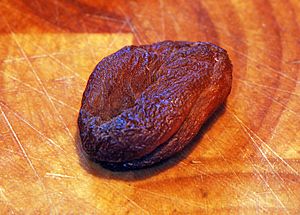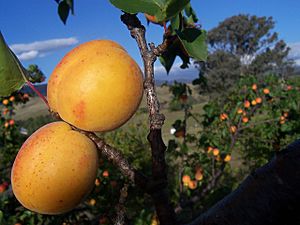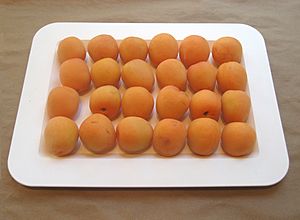Apricot facts for kids
Quick facts for kids Apricot |
|
|---|---|
 |
|
| Apricot fruit | |
| Scientific classification | |
| Kingdom: | |
| Division: | |
| Class: | |
| Order: | |
| Family: | |
| Genus: | |
| Subgenus: | |
| Section: |
Armeniaca
|
| Species: |
P. armeniaca
|
| Binomial name | |
| Prunus armeniaca |
|
Apricot is a drupe fruit. It is closely related to the plum.
Description
- Plant: Small to medium-sized tree, 8 to 12 metres (26 to 39 ft) tall, with a trunk up to 40 cm in diameter with spreading, dense canopy; leaves are shaped somewhat like a heart, with pointed tips, about 8 cm (3 inches) wide.
- Flowers: Flowers are white to pinkish in color.
- Fruit: The fruit has only one seed; the color runs from yellow to orange and may have a red cast; the surface of the fruit is smooth and nearly hairless.
Cultivation
Although the apricot is native to a continental climate region with cold winters, it can grow in Mediterranean climates if there is some cool winter weather to allow a proper dormancy. The dry climate of these areas is good for fruit maturation. The tree is slightly more cold-hardy than the peach, tolerating winter temperatures as cold as −30 °C or lower if healthy. A limiting factor in apricot culture is spring frosts: They tend to flower very early, meaning spring frost can kill the flowers. Furthermore, the trees are sensitive to temperature changes during the winter season. In their native China, winters can be very cold, but temperatures tend to be more stable than in Europe and especially North America, where large temperature swings can occur in winter. Hybridisation with the closely related Prunus sibirica (Siberian apricot; hardy to −50 °C but with less palatable fruit) offers options for breeding more cold-tolerant plants.
Apricot cultivars are most often grafted on plum or peach rootstocks. The scion from an existing apricot plant provides the fruit characteristics such as flavour, size, etc., but the rootstock provides the growth characteristics of the plant. Apricots and plums can hybridize with each other and produce fruit that are variously called plumcots, apriplums, pluots, or apriums.
Dried apricots

Dried apricots are a type of traditional dried fruit. The world's largest producer of dried apricots is Turkey. When treated with sulfur dioxide (E220), the color is vivid orange. Organic fruit not treated with sulfur dioxide is darker in color and has a coarser texture. When apricots are dried, the relative concentration of nutrients is increased, with vitamin A, vitamin E, potassium and iron having Daily Values above 25% (table).
Related pages
Images for kids
-
Preparing apricots in the grounds of Alchi Monastery, Ladakh, India
-
David Packard's apricot orchard in Los Altos Hills, preserved by the David and Lucile Packard Foundation, is one of the few remaining in Santa Clara County, where apricots were a major crop before the urban sprawl of Silicon Valley.
-
Drying apricot fruits (Fergana, Uzbekistan)
-
Dried date, peach, apricot, and stones. From Lahun, Fayum, Egypt. Late Middle Kingdom. The Petrie Museum of Egyptian Archaeology, London
-
Prunus sibirica (Siberian apricot; hardy to −50 °C (−58 °F) but with less palatable fruit)
-
Apricot tree, Turkey
-
Packaging apricot fruits in Uzbekistan
See also
 In Spanish: Prunus armeniaca para niños
In Spanish: Prunus armeniaca para niños
















